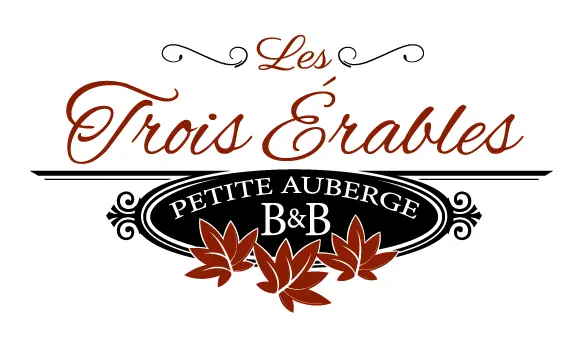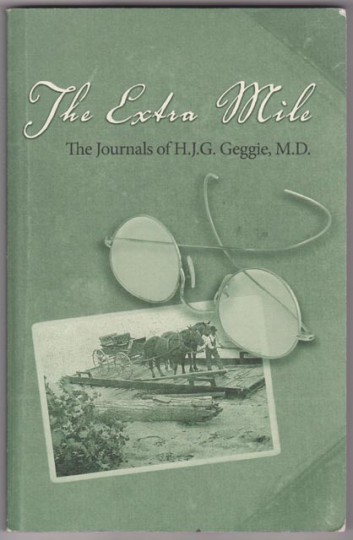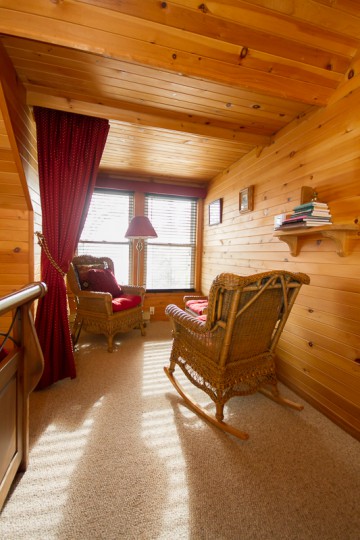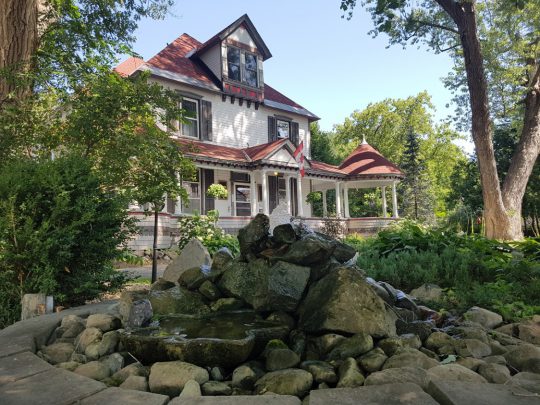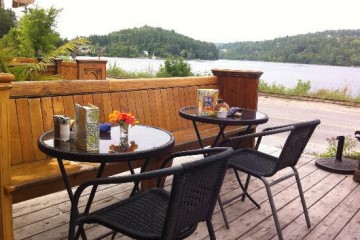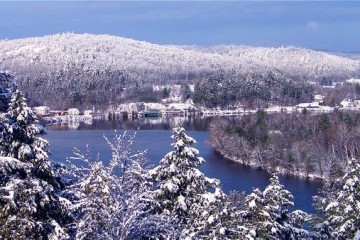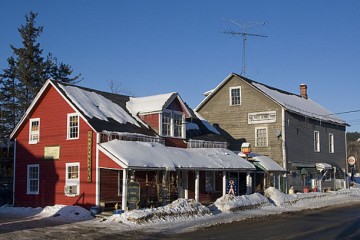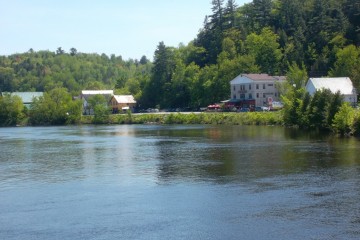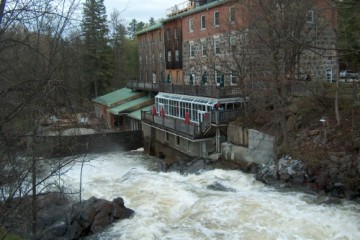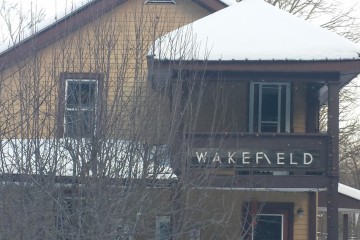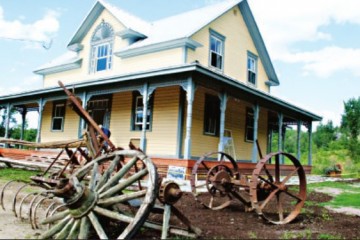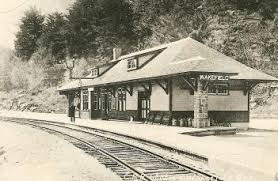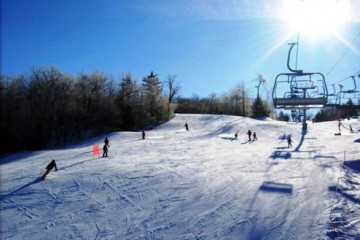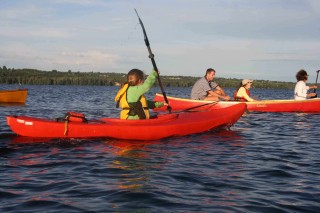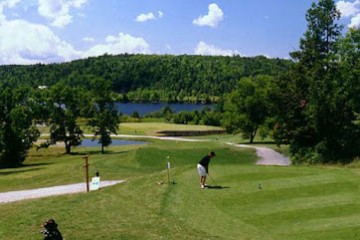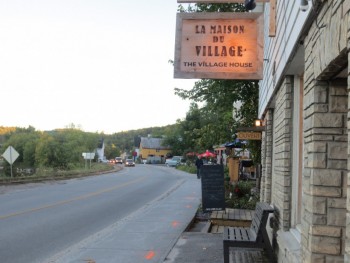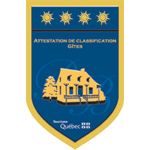Les Trois Erables
Les Trois Érables is not only a beautiful old heritage mansion – it is loaded with local history and lore. It was constructed in 1896 by Dr Hans Stevenson, a country doctor born in Wakefield to Irish immigrants. He hired Moses Edey, a prominent Ottawa architect – who also designed the Aberdeen Pavilion at Lansdowne Park in Ottawa – to design the house.
When you come, you will note Edey’s use of high ceilings, gorgeous stained glass and fine woodwork throughout. It is a Victorian-era house that, with its large wrap-around porch and turrets, is an excellent example of the neo-Queen Anne architectural style. Right on the riverfront in the heart of the village, Les Trois Érables is truly a Wakefield landmark.
Dr Harold Geggie came to Wakefield from Montreal in 1911 to intern with Dr Stevenson, and, upon Dr Stevenson’s unexpected death later that year, nervously assumed his country medical practice. Dr Geggie later purchased the house and even married Dr Stevenson’s daughter, Ella! They had three sons, all of whom became doctors themselves in the family practice. “The Maples”- as the family called the house – was not only the family residence but also the doctors’ office, dispensary and examination and operating rooms.
It was quite a challenge in those days to care for the patients who were widely dispersed in this very rural area – often horse and buggy was the only means of getting around. Many locals tell us today of their experiences of being cared for by the doctors, including being given birth to, right in the house! Dr Geggie – the self-described “simple, country doctor” – lamented the absence of a hospital for the duration of his practice and made it his mission to establish one in Wakefield. His legacy is the Gatineau Memorial Hospital which he founded in 1952. The original building is now Le Manoir seniors residence, just down the road on Riverside Drive at the mouth of the La Pêche River.
The house remained in the Geggie family as “the Doctors’ house” until 1980. It was later transformed into a beautiful bed & breakfast inn, keeping the original features of Moses Edey’s vision of a neo-Queen Anne Victorian mansion. Many of the Geggie family continue to live in the community. In fact, for a fuller description of the history of the house and the community, see some of the publications of Norma Geggie, daughter-in-law to Dr Harold, who at over 90 years old is still very active in promoting historical and social causes in the area. Here is her homage to Dr Geggie on the 100th anniversary of his arrival in Wakefield in 1911.
Come experience part of the history of Les Trois Érables yourself. We have on display many historical photos and artifacts in the guest kitchen, and have made available a copy of Dr Geggie’s memoirs (as recounted by Norma Geggie) in each guest room for you to peruse.
Wakefield
Wakefield at a Glance
Nestled in a postcard-perfect setting along the Gatineau River, the bilingual village of Wakefield possesses a friendly and funky atmosphere created by its diverse residents and nurtured by its surroundings. Whether you’re into nature, art, music, outdoor adventure, shopping or fine food, you’ll fall in love with this place.
Incredibly, this peaceful utopia is a mere twenty-minute drive from downtown Ottawa, Canada’s capital city. A spectacular natural setting with access to a world-class city is what makes Wakefield a truly unique and remarkable village.
Wakefield has developed a reputation for a somewhat bohemian lifestyle and boasts a number of small cafes, pubs, and galleries. Many young families live in the area, enjoying its lifestyle, services, and resources. Many artists live in the surrounding mountains and valleys.
The village’s primary industry is tourism. The main attractions, in addition to a picturesque setting, are the Wakefield Covered Bridge spanning the Gatineau River, the Fairbairn House Heritage Centre, the MacLaren Mill built in 1838 and named after an early family in the region (now restored and operated as the Wakefield Mill Inn and Spa); and, famous for its music, Black Sheep Inn (Auberge Mouton Noir). The village also provides a direct access point to Gatineau Park. Learn more here about Wakefield.
Wakefield History
Wakefield History
Steeped in the history of the log drive, Wakefield owes its existence to settlers who favoured the the junction of the La Pêche and Gatineau rivers. Its magnificent riverfront location surrounded by the beautiful Gatineau Hills has lured cottagers and tourists since the early 1900s. Before that, Wakefield’s lively riverfront served the needs of area farms and distant logging camps.
The area’s first homesteaders were Joseph Irwin and Mary Pritchard, who came to historic Wakefield Township via Bytown (Ottawa) from Northern Ireland in 1829. Ten other Irish families eventually cleared acreages near the townsite. A Scottish millwright and stonemason named William Fairbairn built Wakefield’s first grist mill beside the waterfall on the La Pêche River in 1838. His original house (1861) is now used as the Fairbairn House Heritage Centre near the covered bridge. Fellow countryman David MacLaren, a hardware merchant from Glasgow, built a sawmill in the centre of the village in the 1840s, and then added Fairbairn’s grist mill to his operations. Later he built a large brick three-storey woolen mill, which was a leading employer in the Gatineau Valley until the 1930s. The grist mill has now been converted into the Wakefield Mill Inn and Spa. The brick-clad Edwardian-Gothic style MacLaren House (1860) next door is used for conferences. The MacLaren family cemetery behind the mansion and adjacent to the Trans-Canada Trail contains the grave of former prime minister Lester B. Pearson.
Many of Wakefield’s original inns, churches, stores and homes remain. The Earle House (circa 1880) on the corner of Valley and Riverside drives, belonged to Robert Earle, a carpenter, carriage-maker and blacksmith is now the Cafe Molo. Patterson’s General Store at 740 Riverside Dr (circa 1880) is now the Jamboree gift shop and retains much of its original interior. The Wakefield train station (1892) operated as the Pot-au-Feu Restaurant since 1970. And, of course, there is our own Les Trois Érables, the neo-Queen Anne style doctor’s residence built in 1896. A number of Wakefield homes have been awarded heritage plaques by the Municipality of La Pêche. Many are our neighbours on chemin Burnside which makes for a lovely walk up the street from Les Trois Érables.
Lastly, there is the iconic Wakefield Covered Bridge, a striking replica of an older structure destroyed by fire in 1984. No visit to Wakefield is complete without a stroll across the covered bridge.
Learn more about the history of Wakefield and some of its key historical figures:
Activities and Attractions
Activities and Attractions

Wakefield Village itself has so much to offer, but it is also the hub to access a variety of other attractions in the Gatineau Hills just minutes away.
- artists
- festivals (Dragonfest Winter Festival, Ta Da Theatre Festival, Wakefield International Film Festival, Wakefield Writers Festival, Chelsea Wakefield Artists Studio Tour)
- music venues
- Canada Day
- Earth Day
- Wakefield Trails / Trans Canada Trail
- heritage walks
- bungee jump
- aerial park
- scuba diving
- horseback riding
- cross-country skiing
- downhill skiing
- golf
- Gatineau Park
- environmental exploration
- cycling
- mountain biking
- driving tours
- farm visits
- farmers market
- running events
- canoe/kayak
- wilderness tours
- swimming
Eateries
Eateries
Many of our guests seek in advance to choose and reserve their seats at one or more of Wakefield’s many fine dining establishments. We provide you with a complete list here to help you with that.
Bon appétit!
Sit-down Restaurants
Nikosi
Nikosi Bistro-Pub fuses French cuisine with Indigenous ingredients. Beautiful patio. $$ https://nikosibistropub.com/?lang=en
La Maison du Village
Perhaps the most highly rated restaurant in Wakefield right now. An adventurous menu of meat and other dishes that in our opinion rank with the best anywhere. Small outdoor deck, but it’s the food you go for. $$$ https://www.thevillagehouse759.com/
Kaffe 1870
Where many locals go. Great selection of draft beer and innovative pub food. Live music weekend evenings, and open mike on Wednesdays. Check out the food theme nights – Perogie Night or Steak Night! $ https://www.facebook.com/kaffe1870/
Wakefield Mill
Five-star dining and ambiance – try a window seat in the Heron Room overlooking the waterfall. Great lounge for pre-dinner drinks and jazz entertainment on weekend evenings. Sunday brunch is a big draw. $$$$ https://wakefieldmill.com/dining/muse-restaurant/
Bistro Rutherford
Great burgers and lighter fare. Shares its deck (and beer) with the Black Sheep – overlooks the river and convenient if you’re going to the show next door. $ http://www.bistrorutherford.ca/
Le Hibou
Good food, funky retro décor and a fabulous deck overlooking the river. Occasional live entertainment. $$ https://www.cafelehibou.com/
Ixim
Latin American foods and specialty drinks. $$ https://iximcafebistro.com/
Casual/Take-out Restaurants
Maison Earle House
Recently renovated with coffee, pastries and light fare. Weekly entertainment and beautiful terrace overlooking the river. https://www.cafeearle.com/
Bluebarn Cafe
Specialty coffee roasters with interesting foods and a beautiful patio. https://bluebarncoffee.com/
Jos Wakefield – upscale casse-croute serving up delicious duck poutine and take-home comfort food. https://www.bytownjos.com/
Jean Burger – a Wakefield favourite, with hamburgers, fries and “the best poutine ion Quebec”! https://jburger.ca/
Subway
The usual subs located in the shopping centre at the intersection of Route 105 and chemin de la Vallée de Wakefield.
Tim Horton’s
The usual Tim’s fare located in the shopping centre at the intersection of Route 105 and chemin de la Vallée de Wakefield.
Bakeries
Wakefield Bakery – Excellent selection, the best baguettes outside of France! https://www.facebook.com/Wakefield-Bakery-631973976826491/
Pipolinka – Excellent organic baked goods, and chili and soups on offer as well. https://www.pipolinka.ca/
